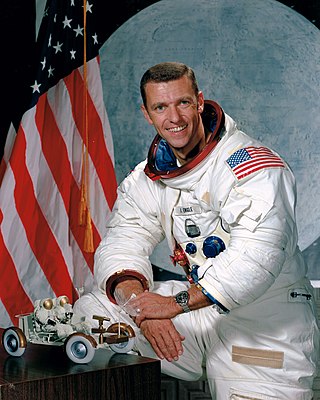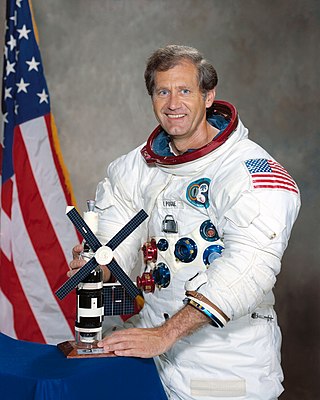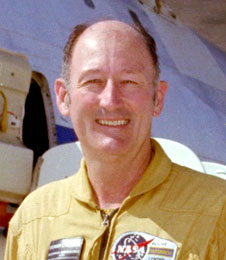Related Research Articles

Scaled Composites is an American aerospace company founded by Burt Rutan and currently owned by Northrop Grumman. It is located at the Mojave Air and Space Port in Mojave, California, United States. Founded to develop experimental aircraft, the company now focuses on designing and developing concept craft and prototype fabrication processes for aircraft and other vehicles. It is known for unconventional designs, for its use of non-metal, composite materials, and for winning the Ansari X Prize with its experimental spacecraft SpaceShipOne.

The Rutan Model 76 Voyager was the first aircraft to fly around the world without stopping or refueling. It was piloted by Dick Rutan and Jeana Yeager. The flight took off from Edwards Air Force Base's 15,000 foot runway in the Mojave Desert on December 14, 1986, and ended 9 days, 3 minutes and 44 seconds later on December 23, setting a flight endurance record. The aircraft flew westbound 26,366 statute miles at an average altitude of 11,000 feet (3,350 m).

The Ansari X Prize was a space competition in which the X Prize Foundation offered a US$10,000,000 prize for the first non-government organization to launch a reusable crewed spacecraft into space twice within two weeks. It was modeled after early 20th-century aviation prizes, and aimed to spur development of low-cost spaceflight.

The Robert J. Collier Trophy is awarded annually for the greatest achievement in aeronautics or astronautics in America, with respect to improving the performance, efficiency, and safety of air or space vehicles, the value of which has been thoroughly demonstrated by actual use during the preceding year.

Eileen Marie Collins is a retired NASA astronaut and United States Air Force (USAF) colonel. A former flight instructor and test pilot, Collins was the first woman to pilot the Space Shuttle and the first to command a Space Shuttle mission.

Elbert Leander "Burt" Rutan is a retired American aerospace engineer and entrepreneur noted for his originality in designing light, strong, unusual-looking, and energy-efficient air and space craft. He designed the record-breaking Voyager, which in 1986 was the first plane to fly around the world without stopping or refueling. He also designed the Virgin Atlantic GlobalFlyer, which in 2006 set the world record for the fastest and longest nonstop non-refueled circumnavigation flight in history. In 2004, Rutan's sub-orbital spaceplane design SpaceShipOne became the first privately funded spacecraft to enter the realm of space, winning the Ansari X-Prize that year for achieving the feat twice within a two-week period.

Joe Henry Engle was an American pilot, aeronautical engineer, and NASA astronaut. He was the commander of two Space Shuttle missions including STS-2 in 1981, the program's second orbital flight. He also flew two flights in the Shuttle program's 1977 Approach and Landing Tests. Engle was one of twelve pilots who flew the North American X-15, an experimental spaceplane jointly operated by the Air Force and NASA.

Charles Gordon Fullerton was a United States Air Force colonel, a USAF and NASA astronaut, and a research pilot at NASA's Dryden Flight Research Facility, Edwards, California. His assignments included a variety of flight research and support activities piloting NASA's B-52 launch aircraft, the Boeing 747 Shuttle Carrier Aircraft (SCA), and other multi-engine and high performance aircraft.

Jeana Lee Yeager is an American aviator. She co-piloted, along with Dick Rutan, the first non-stop, non-refueled flight around the world in the Rutan Voyager aircraft from December 14 to 23, 1986. The flight took 9 days, 3 minutes, and 44 seconds and covered 24,986 miles (40,211 km), almost doubling the old distance record set by a Boeing B-52 strategic bomber in 1962.

William Reid "Bill" Pogue was an American astronaut and pilot who served in the United States Air Force (USAF) as a fighter pilot and test pilot, and reached the rank of colonel. He was also a teacher, public speaker and author.

Thomas Patten Stafford was an American Air Force officer, test pilot, and NASA astronaut, and one of 24 astronauts who flew to the Moon. He also served as Chief of the Astronaut Office from 1969 to 1971.

Richard Glenn Rutan was an American military aviator and officer, as well as a record-breaking test pilot who in 1986 piloted the Voyager aircraft on the first non-stop, non-refueled around-the-world flight with co-pilot Jeana Yeager. He was the older brother of famed aerospace designer Burt Rutan, whose many earlier original designs Dick piloted on class record-breaking flights, including Voyager.
The International Space Development Conference (ISDC) is the annual conference of the National Space Society (NSS). Now in its 41st year, these conferences connect the general public and the NSS membership with leaders of contemporary space efforts. The ISDC provides a nexus for industry, government, scientists, advocates, and the public to meet and discuss the latest issues in space technology, science, policy, commerce, medicine, exploration, settlement and much more. Winners of the annual NASA space settlement Contest annually attend the conference, with several interesting activities and programs. With National Space Society's major goal being to accelerate the process of space exploration and development they also foster astronautics for students by encouraging them and getting them involved.

The James H. Doolittle Award is an honor presented annually by the Society of Experimental Test Pilots. It is an award for "outstanding accomplishment in technical management or engineering achievement in aerospace technology". The award consists of a perpetual trophy on permanent display at SETP headquarters, and a smaller replica presented to the recipient. It is named after General James Doolittle, famous for the Doolittle Raid on Tokyo during World War II.

Fitzhugh L. "Fitz" Fulton, Jr., , was a civilian research pilot at NASA's Dryden Flight Research Center, Edwards, California, from August 1, 1966, until July 3, 1986, following 23 years of distinguished service as a pilot in the U.S. Air Force.

Michael Reed "Mike" Barratt is an American physician and a NASA astronaut. Specializing in aerospace medicine, he served as a flight surgeon for NASA before his selection as an astronaut and has played a role in developing NASA's space medicine programs for both the Shuttle–Mir program and International Space Station. His first spaceflight was a long-duration mission to the International Space Station as a flight engineer on the Expedition 19 and 20 crew. In March 2011, Barratt completed his second spaceflight as a crew member of STS-133. Barratt made a second long-duration mission to the International Space Station as a flight engineer on the Expedition 70, 71, and 72 crew and also served as the pilot on the SpaceX Crew-8 mission.
A space competition is an inducement prize contest offering a prize to be given to the first competitor who demonstrates a space vehicle, or a space exploration apparatus, which meets a set of pre-established criteria. It spurs pioneering development in private spaceflight.

John Revell "Jack" Dailey is a retired United States Marine Corps four-star general who served as Assistant Commandant of the Marine Corps (ACMC) and Chief of Staff from 1990 to 1992, Acting Associate Deputy Administrator of the National Aeronautics and Space Administration (NASA) from 1992 to 1999; and director of the National Air and Space Museum (NASM) from 2000 to 2018.

Jerauld Richard "Jerry" Gentry was a United States Air Force (USAF) test pilot and Vietnam combat veteran. As chief USAF pilot of the Lifting Body Research Program, he helped validate the concept of flying a wingless vehicle back to Earth from space and landing it like an aircraft—an approach used by the Space Shuttle and to a greater degree by vehicles such as the Lockheed Martin X-33 and NASA X-38. Gentry completed thirty lifting body flights including the first flight of the Martin-Marietta X-24A and the second flight of the Northrop HL-10.

John R. Casani is an American engineer. He worked for the National Aeronautics and Space Administration (NASA) at the Jet Propulsion Laboratory, where he managed the Voyager, Galileo, Cassini and Prometheus projects.
References
- ↑ "Michael Collins Trophy". National Air and Space Museum. 18 June 2016. Retrieved May 6, 2022.